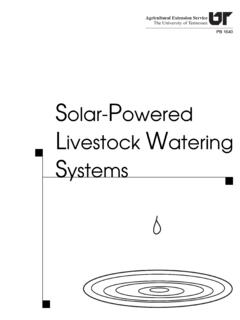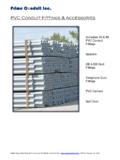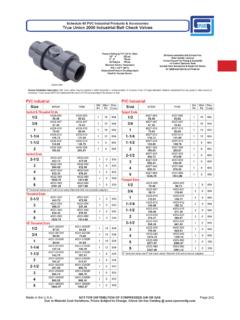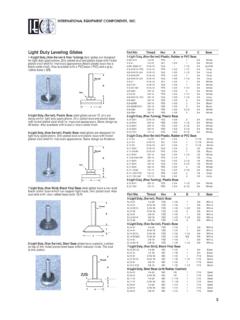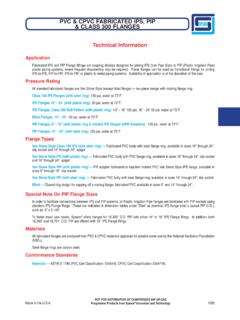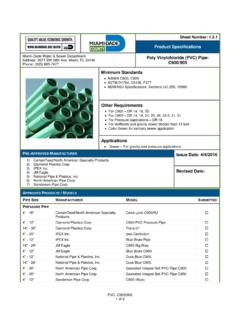Transcription of PVC Pool Heating Collector – Version 1 10/23/2012
1 PVC Pool Heating Collector Version 1 10/23/2012 . 1. Why It may seem strange to some why you would build a pvc pool Collector as it probably ends up being very close in money and maybe even more money then a traditional pool Heating Collector . By traditional I. mean the flat plastic material mat(search fafco pool heater). Some are made of edpm and are a bit more money and some are made of polypropylene. Some homemade cheaper ones are made out or irrigation tubing. Well to the reason. I found myself in part of the world that likes to tax foreign products. So something like a $150 pool Collector could turn out to be $500 dollars. In this case you can build the pvc Collector for less than the $500 and probably pretty close to the $150 for an equal sized Collector .
2 In the USA. you probably can find used pool collectors very cheap if you look around and more so if you are in the southern USA (where there are many more pools). My initial design and implementation came from lack of product locally and the lead time of 30+ days. The following pvc Collector does take a bit of time but really can be made fairly easily if you take your time. I am going to go into some design considerations, then go to the actual build. Unfortunately I did not take any photos of my initial implementation but I did do some drawings. In the future I plan to make another system and as I do it I will take pictures along the way and update this document.
3 This following system I will also do extensive data logging which be included in an updated Version of this document. 2. Design Considerations Here are a few things to think about. a. Head loss It may look very easy to make a big coil of irrigation hose and just pass water through it. IT IS. But it is not very efficient. When you have very long lengths of tubing the amount of friction the water has to overcome to get to the other side is great. This results in very low flow rate, and/or excessive pumping power needed to make things flow. One of my first solar collectors was a big coil. Fortunately I did use large tubing diameter but it still cut down greatly on flow.
4 The larger the tubing the less effect friction has. Some might say well just make the tubing very large. That is possible but really not the best use of resources. First large diameter tubing/pipe costs much more than small stuff. Secondly plastics are commonly made from oil. More plastic=more oil. So to remedy this design flaw of high friction larger pipes is not the best solution. It maybe a solution if you get the material for free or have extra but for everyone else there is a better way. Any easy solution is something called parallel flow. Say you were thinking of 1000 ft of 1 irrigation tubing. If it is one long loop it is called series flow as all the water flows in series.
5 Now if you split that tubing into say 10 equal lengths (ie 100ft each) you can make 10. Contributed by Matthew Wright See more projects at smaller coils 100ft each. The water flows through a large pipe and can go into any of the 10 loops . The water splits up (with good design) equally along the 10 loops /lengths. This is called parallel flow as the water can flow parallel to itself through other channels. Say in the original 1000ft coil you wanted 5. gallons per minute to flow through. It is very easily to calculate the head loss(frictional loss). But it is very easy to imagine as well. The 5 gallons have to all flow in basically a line until they come out the other side.
6 When there are 10 100ft sections the water splits 10 ways. Each 100ft section now only has to have 5gpm/10 = .5gpm flowing through it. Thus the frictional loss(head loss) is greatly reduced as the water meanders through the pipe, instead of racing through it as was when it was all one long piece. Also something to consider is the longer the pipe is the more friction that happens so as well as the water traveling slower in the parallel setup, it actually touches less pipe as well. When water molecule A. travels series loop(1000ft) it travels the whole loop. So the whole 1000ft it is in friction with the pipe. In parallel flow molecule A only travels through 1 section of 100ft.
7 I will try to explain using an example of car. While no exactly the case, it is fairly accurate. Series flow is like driving from NYC to LA in a 1 lane road. Ie no passing, everyone is in a line and is horrible driving and takes for ever. Parallel flow cut into 10 equal parts is now like driving on one of 10 single lane roads with the same amount of cars that were on the single lane road. Things should speed up a lot. On top of this instead of driving 3000 miles from NYC to LA it now is only a trip of 300 miles. I do not know about you but for me driving a 300 mile trip seems much better than taking all those cars and putting them on a single 1. lane road and driving 10 times as long.
8 So following the analogy this will allow a much great flow rate for the water in the panel for a given pump. But if flow rate was keep the same for entire panel it would mean that the water per channel would be moving at a slower rate. Higher flow rates always collect more solar energy than slower flow rates but there is a point where the pumping at higher rates increases electricity consumed but does not significantly increase solar energy collection. On each system the balance between energy collected and energy spent is different but pool collectors are usually recommended to have .1gpm of flow per sqft of Collector . So a 10sqft Collector would have optimum solar collection around 1gpm.
9 A 100 sqft Collector would have a flow recommendation of 10gpm. And say a 400sqft Collector would have a recommendation of 40gpm. It may sound like a lot of flow but pools are almost always flowing large volumes of water. But it should be noted a pvc pipe header causes much greater flow restriction to 40 gpm than does 2 or pvc piping. Water always takes the pass of least resistance. The only benefit of series flow is that you can make sure the water flows evenly over the entire area. Once you start breaking things into pieces if not done properly more water may flow over certain pipes and very little in others thus possibly reducing efficiency. Related back to cars it would be like having 10 single lane roads but in varying length from 350miles to 250 miles.
10 More cars would be on the 250 mile road. The idea with parallel with water is you want everything spaced out evenly. Something to take away is the parallel flow greatly reduces head loss. It just needs a little more attention to detail. If the detail is followed great results can be had. It is the more efficient design of a system. b. Even Flow To make sure the water splits up equally you must make the flow resistance along the 10 loops very Contributed by Matthew Wright See more projects at similar. This is done by various means. First the main distribution (header) should be much larger in diameter than any individual loop. This would be like an 8 lane highway splitting into 10 single lane roads.
